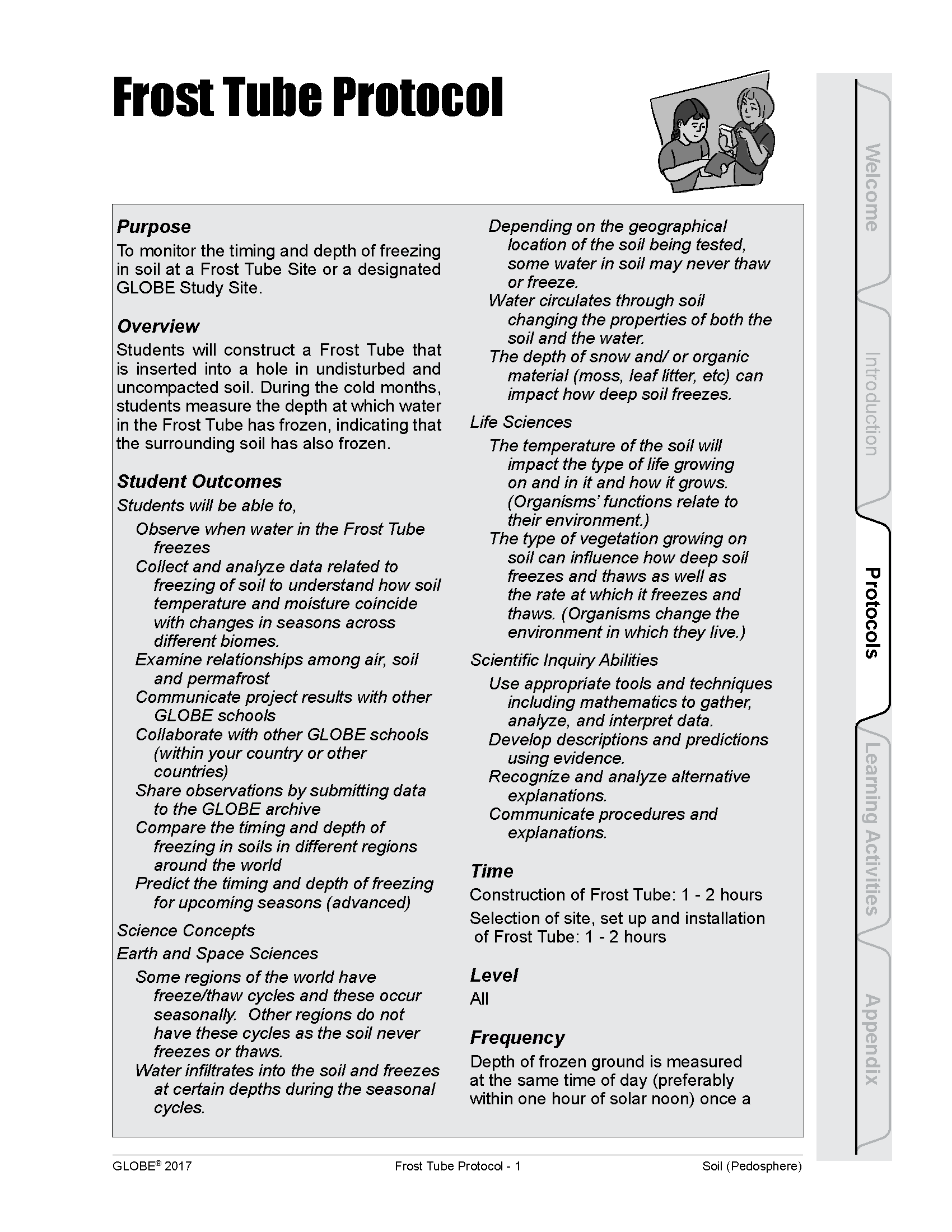GLOBE Connections
GLOBE Pedosphere (Geosphere) Protocols & Related ESDE Datasets
My NASA Data features resources for GLOBE protocols that provide connections to NASA datasets in the Earth System Data Explorer, as well as background information for the protocol, student data sheets, and related learning activities. For more information on GLOBE or Pedosphere (Geosphere) protocols see the resources at the bottom of the page. It is important to note that a particular protocol may support more than one phenomenon and may support phenomena from different spheres. To see how individual protocols relate to a particular phenomenon, you can visit the GLOBE Connection for that phenomenon (i.e., Changes in Land Surface/Land Use Change, Soil Moisture, Volcanic Eruptions, etc.)
Related Earth System Data Explorer datasets:
The datasets in My NASA Data's Earth System Data Explorer which supplement exploration of each protocol are also indicated. These supplemental datasets may measure the same variable or related variables, and they may have a different temporal scale. Specific research questions may also have additional supporting datasets which can be explored. All data available through My NASA Data can be found on the Data Collections: Earth System Data Explorer page.
Explore the MND GLOBE Connections Datasets spreadsheet to review the range of Geosphere datasets in the Earth System Data Explorer by visiting this link.
The GLOBE Pedosphere (Geosphere) protocols related to phenomena or datasets supported by My NASA Data (MND) are outlined below. Under each protocol, there is a list of related Earth System Data Explorer datasets.
Frost Tube
These data are related to soil moisture, which can include frozen moisture, albedo, surface temperatures and the percent coverage of snow and ice in each pixel, including snow, land ice, and sea ice. Changes in these data may be related to observed changes in frost tube data.
- Monthly Daytime Surface (Skin) Temperature
- Monthly Albedo Measured at the Surface
- Monthly Snow/Ice Percent Coverage
- Monthly Nighttime Surface (Skin) Temperature

Soil Infiltration
Soil moisture and infiltration are related. Students' investigations may look at both, compare them or look for correlation.
- Daily Precipitation Amount
Groundwater Storage Percentile - August 6, 2019
Soil Moisture
Students observe daily or monthly soil moisture. They also evaluate the groundwater storage and relate these data to infiltration, weather events and vegetation in an area.
- Daily Soil Moisture
- 7-day Average Groundwater Storage Percentile
- Monthly Mean Soil Moisture
- 7-day Average Root Zone Soil Moisture Prcentile
- Daily Precipitation Amount
- Monthly Average Precipitation Rate
Soil pH
Soil moisture and precipitation have a direct relationship with soil pH. In areas with higher precipitation, soil pH is decreased (soil becomes more acidic) by a process called soil leaching. Rainforests, for example, have soils with low pH because of the high amounts of rainfall. Sulfate aerosols make rain acidic (acid rain) when they rain out of the atmosphere. Areas with high sulfate aerosols also have acidic soil.
- Monthly Air Column Concentration of SO2
- Daily Precipitation Amount
- Monthly Average Precipitation Rate
Soil Temperature
Students can compare soil temperature to surface skin temperature. This can be used when looking at temperature or Earth's energy budget.
- Monthly Daytime Surface (Skin) Temperature
- Monthly Surface Air Temperature
- Monthly Surface Air Temperature Anomaly
- Monthly Nighttime Surface (Skin) Temperature
- Monthly Surface (Skin) Temperature
GLOBE Pedosphere (Geosphere) Protocol Information
GLOBE Pedosphere (Geosphere) protocols can be found on the GLOBE website. Each GLOBE protocol page will have information for the protocol, data sheets, and related learning activities. Online e-Training is available.
GLOBE Protocol Bundles
Protocol bundles are designed to use related protocols from different spheres to investigate different topics. The following protocol bundles include at least one atmosphere protocol. The GLOBE protocol bundles can be found on the GLOBE website.
Visit the following links to explore the Earth System Data Explorer datasets that may be used to support students who are exploring their communities using the GLOBE protocol bundles.


